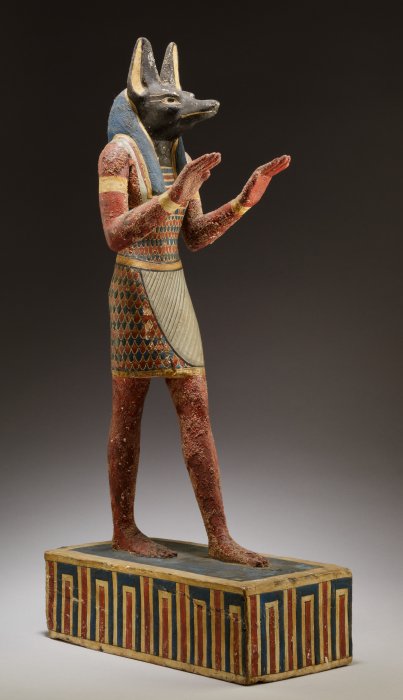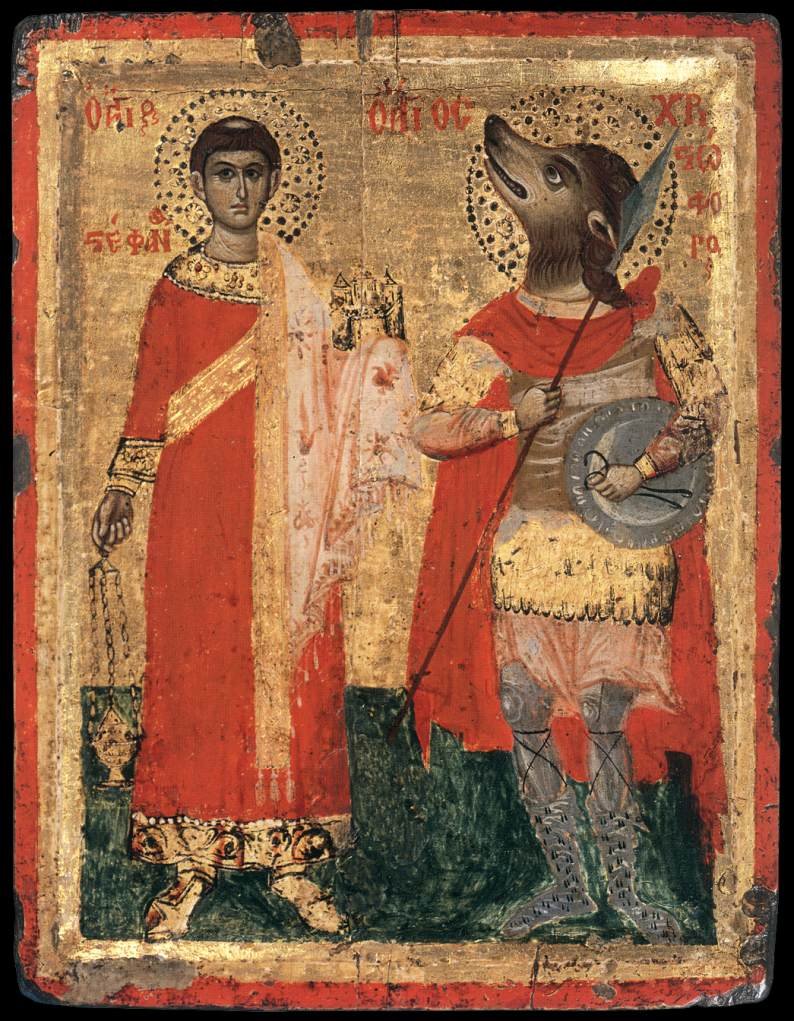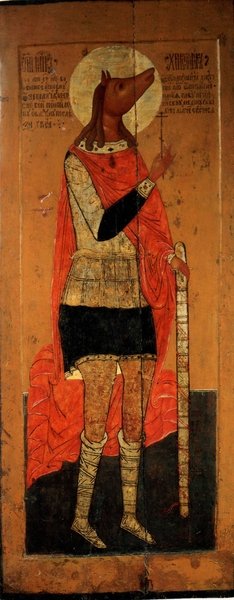Mysterious Dog-Headed St. Christopher Reminds Of The Egyptian Jackal God Anubis

Ellen Lloyd – AncientPages.com – The lives of many saints are often shrouded in mystery. St. Christopher, who died as a martyr, is one of the most venerated Christian saints.
Yet, there is a lot we don’t know about the man who died as a martyr. The truth is that we don’t even know if he existed in the first place.
What is even more intriguing is that in the Byzantine Museum in Athens, Greece, we come across something remarkable, something that could shed light on his identity. Here, we find an icon of a Dog-Headed St. Christopher. Why is St. Christopher depicted with a dog head?
What Does Jackal God Anubis Have In Common With St. Christopher?
It’s curious because the holy Christian reminds of the Jackal God Anubis, one of the immortal Egyptian gods. In the underworld, Anubis was the protector of the dead bodies. His widely known epithet, the ‘Lord of the sacred land’ or ‘Lord of the pure land’ emphasized his supreme power over desert areas covered with necropolises. Also, his title, ‘He who is upon his sacred mountain,’ relates to the jackal god watching over the burials of the dead from the heights of the desert cliffs.
In the Pyramid Texts, there is a reference to ‘the Jackal, the Governor of the Bows,’ more precisely, nine bows—nine figures depicted as literal bows, probably representing captives—the enemies of Egypt.
Statuette of Anubis. Ptolemaic Period 332–30 B.C.. Credit: MET
According to the Catholic Church, St. Christopher is the patron of bachelors, transportation, traveling, storms, epilepsy, gardeners, holy death, and toothache.
Legend Of St. Christopher
The legend of Christopher, also known as Offero, is shrouded in a blend of fact and fiction. Originally from Canaan, he was a towering figure who sought a master worthy of his service. Initially, he served a nobleman but left due to the master’s fear of the devil. Offero then served the devil himself but witnessed the devil’s terror at the sight of a cross, leading him to believe that Christ must be an even greater master. He embarked on a quest to find and serve Christ.
Along his journey, Offero encountered a hermit who advised him to serve Christ by carrying travelers across a nearby torrent. One stormy night, he carried a mysterious child on his back, who weighed heavier than any burden he had ever borne. He persevered and reached the other side despite nearly sinking in the raging waters. Upon planting his staff in the bank, it miraculously sprouted leaves, revealing that his passenger was none other than Jesus himself. From that moment on, he became known as Christopher, the Christ-bearer.
The cult of Christopher gained significant popularity during the medieval period but declined in the 17th century. However, in the modern age of motor and air travel, the legend of Christopher has experienced a resurgence, resonating with a new generation.
The Mysterious Dog-Headed Race
Historians, artists, and scholars have long debated why St. Christopher is depicted with a dog’s head. St. Christopher is usually depicted as a giant man with a child on his shoulder and a staff in one hand.
Some scholars suggest his depiction in Eastern Orthodox icons with a dog head is simply a mistake that resulted from a misinterpretation of the Latin term Cananeus (Canaanite) to read canineus (canine).
Ancient legends mention a mysterious dog-headed race that once lived among men. According to the Orthodox Arts Journal, “dog-headed men appear in the story of St-Mercurios, a warrior saint whose father was eaten by two dog-headed men later converted by St-Mercurios.
These dog-headed men’s savage nature could be unleashed by St-Mercurios on the enemies of the Roman empire in a way analogous to how Romans and later Christians used Barbarians in their own wars.”
17th-century icon of St. Stephen and St. Christopher. Unknown painter. Public Domain
In Medieval times, it was commonly accepted that there were several types of races, the Cynocephalus, or dog-headed people, being one of many believed to populate the world. Walter of Speyer, a German poet and writer, portrayed St. Christopher as a giant of a cynocephalic species in the land of the Chananeans who ate human flesh and barked.
The use of dog-headed men in iconography is not limited to the icon of St. Christopher. These enigmatic beings appear also in images of Pentecost, prominently in Armenian manuscripts and in Western images.
Did St. Christopher Exist?
Tracing St. Christopher’s life and death requires extensive research. We don’t know his true identity. Historical evidence is based on legends that suggest this intriguing man lived during the Christian persecutions of the Roman emperor Decius (249 to 251) and was captured and martyred by the governor of Antioch.
Historian David Woods has proposed that St. Christopher’s remains were possibly taken to Alexandria by Peter of Attalia, where he may have become identified with the Egyptian martyr Saint Menas.
It is worth mentioning that in the British Museum there is also an interesting bronze figure representing the God Bes carrying a child on his shoulders. Researchers have discovered several curious iconic parallels in ancient Egypt with the Christopher figure we encounter in our Medieval churches.
The Orthodox icon of St. Christopher presents him as a warrior cynocephalus, a dog-headed man from Lycea. Sometimes, he is also gigantic in size. According to his tradition, he was a Roman soldier taken from the far end of the world who converted and was martyred by an Emperor. Credit: Public Domain
St. Christopher died because he refused to sacrifice to the pagan gods. The king ordered him to be killed. Various attempts failed, but finally, Christopher was beheaded. Before his death, St. Christopher had managed to convert thousands of people to Christianity. His feast is on July 25 every year.
Written by Ellen Lloyd – AncientPages.com
Copyright © AncientPages.com All rights reserved. This material may not be published, broadcast, rewritten or redistributed in whole or part without the express written permission of AncientPages.com
Expand for references








